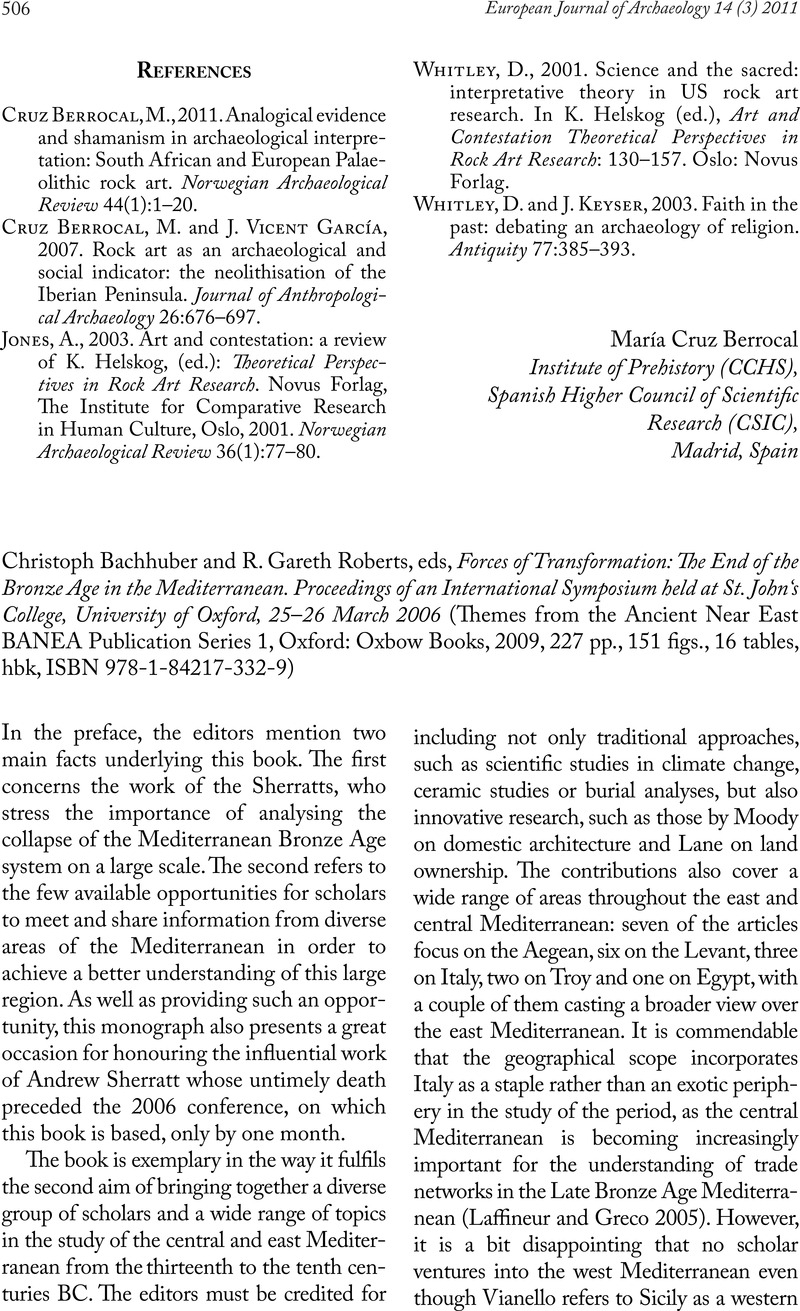No CrossRef data available.
Article contents
Christoph Bachhuber and R. Gareth Roberts, eds, Forces of Transformation: The End of the Bronze Age in the Mediterranean. Proceedings of an International Symposium held at St. John's College, University of Oxford, 25–26 March 2006 (Themes from the Ancient Near East BANEA Publication Series 1, Oxford: Oxbow Books, 2009, 227 pp., 151 figs., 16 tables, hbk, ISBN 978-1-84217-332-9)
Published online by Cambridge University Press: 25 January 2017
Abstract
An abstract is not available for this content so a preview has been provided. Please use the Get access link above for information on how to access this content.

- Type
- Reviews
- Information
- Copyright
- Copyright © 2011 Maney Publishing
References
Broodbank, Ο., 2010. Braudel's Bronze Age. In Krzyszkowska, O. (ed.), Cretan Offerings: Studies in Honour of Peter Warren. British School at Athens Studies
18: 33–40. Athens: British School at Athens.Google Scholar
Knapp, A.B. and Blake, E., 2005. Prehistory in the Mediterranean: the connecting and corrupting Sea. In Blake, E. and Knapp, A.B. (eds), The Archaeology of Mediterranean Prehistory: 1–23. Oxford: Blackwell.Google Scholar
Laffineur, R. and Greco, E. (eds), 2005. Emporia: Aegeans in the Central and Eastern Mediterranean. Proceedings of the 10th International Aegean Conference 10e Rencontre égéenne internationale. Athens, Italian School of Archaeology, 14-18 April 2004. Program in Aegean Scripts and Prehistory. Liège and Austin: Université de Liège, Histoire de l'Art et Archéologie de la Grèce Antique and University of Texas, Aegaeum 25.Google Scholar
Sherratt, S., 1998. ‘Sea peoples’ and the economic structure of the late second millennium in the eastern Mediterranean. In Gitin, S., Mazar, A. and Stern, E. (eds), Mediterranean Peoples in Transition: Thirteenth to Early Tenth Centuries BCE: 292–313. Jerusalem: Israel Exploration Fund.Google Scholar
Sherratt, S., 2010. The Aegean and the wider world: some thoughts on a world-systems perspective. In Parkinson, W.A. and Galaty, M.L. (eds), Archaic State Interaction: The Eastern Mediterranean in the Bronze Age: 81–106. Santa Fe: School for Advanced Research.Google Scholar
Sherratt, A.G. and Sherratt, S., 1998. Small worlds: interaction and identity in the Ancient Mediterranean. In Cline, E.H. and Harris-Cline, D. (eds), The Aegean and the Orient in the Second Millennium: Proceedings of the 50th Anniversary Symposium, Cincinnati, 18-10 April 1997: 329–343. Program in Aegean Scripts and Prehistory. Liège and Austin: Université de Liège. Histoire de l'Art et Archéologie de la Grèce Antique and University of Texas, Aegaeum 18.Google Scholar
Stein, G.J., 1999. Rethinking world-systems: power, distance, and diasporas in the dynamics of interregional interaction. In Kardoulias, N.P. (ed.), World-System Theory in Practice: Leadership, Production, and Exchange: 153–178. Lanham: Rowman & Littlefield Publishers Inc.Google Scholar




